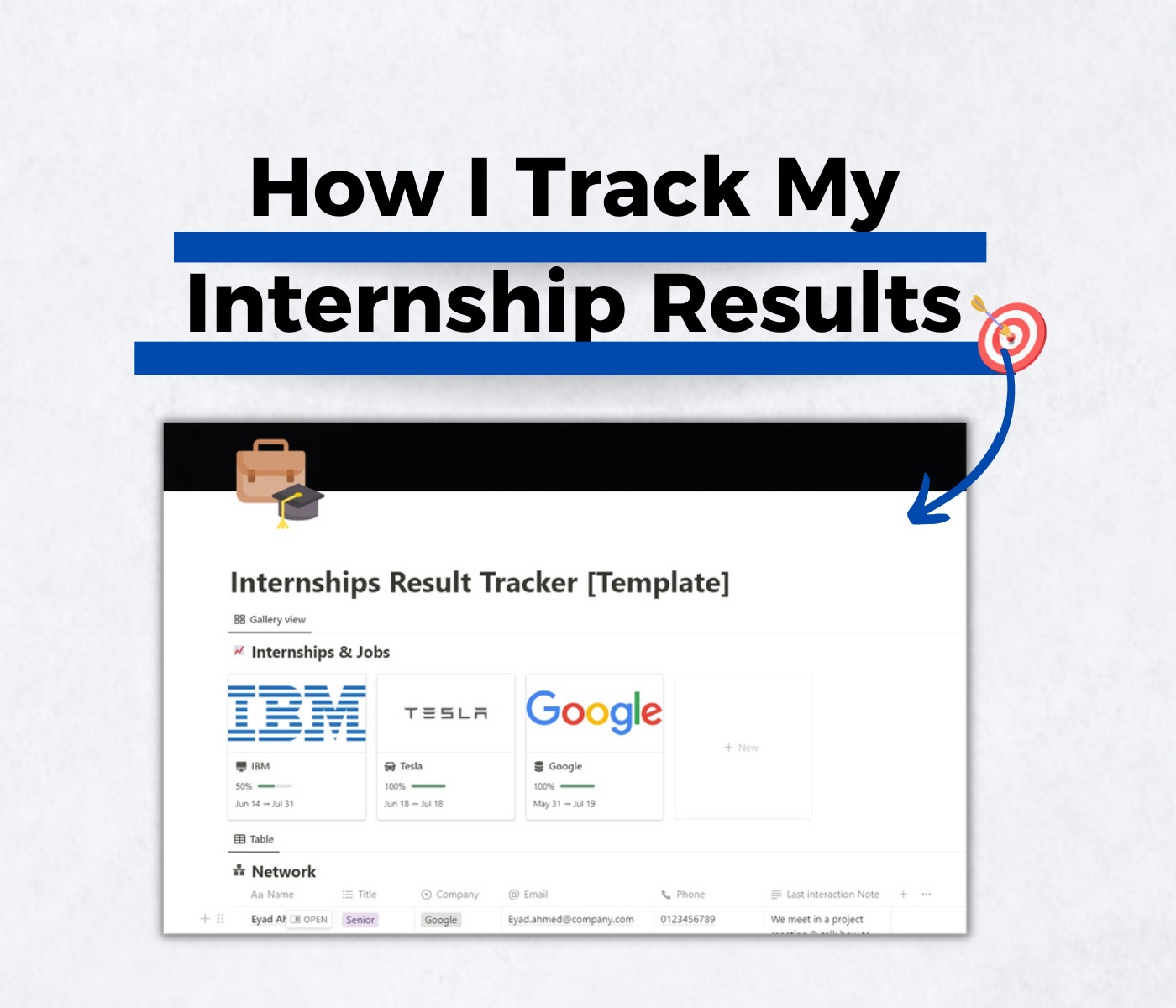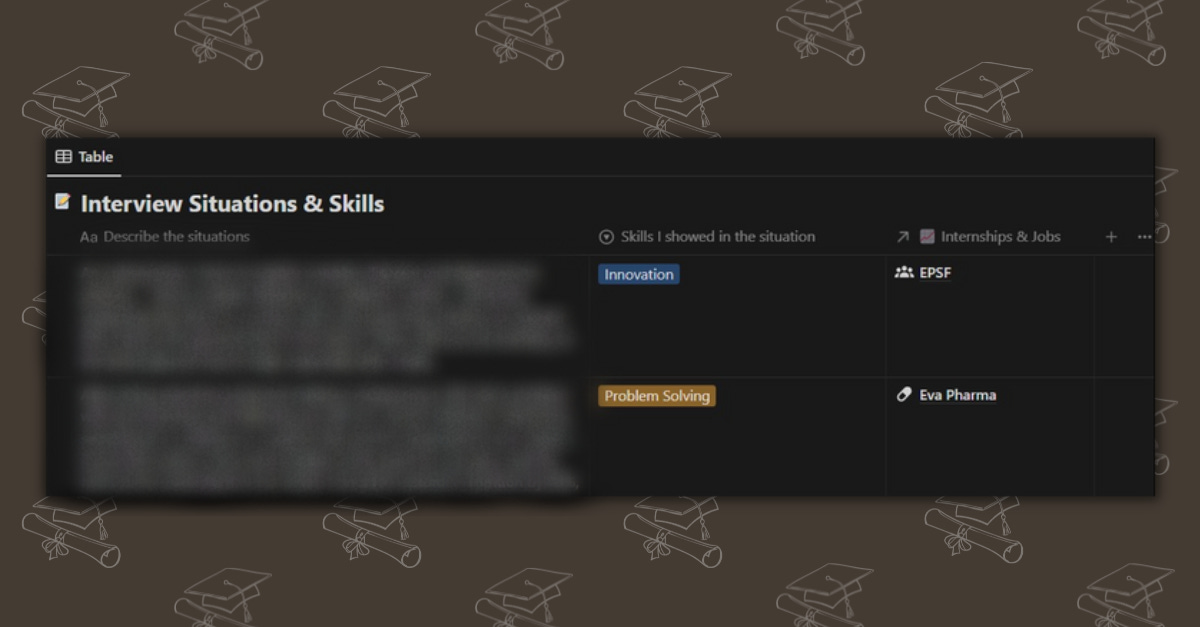How I track my internship results [+Template]
Track your relations, achievements, and the skills you develop.
Hi, Ahmed here! each week I share actionable ideas about studying strategies, college life stories, and job search advice for students and fresh graduates.
If you missed the previous newsletter issue you can check it through this link:
Expected reading time: 6 minutes.
Hope you enjoy it.
Ever heard the phrase 'if it’s not documented, it’s not done'? The same principle applies to your internship.
You invest your time and effort into it, so make sure you get the most value from the experience. Document everything, from the projects and tasks of your internship to the relations you had there.
I know, this is easier said than done, and if you’re anything like me, you don’t find it fun to write and document stuff.
I used to struggle whenever I needed to prepare for an interview or update my resume or even recall what I did in my previous internship.
That’s when I started to track everything I worked on and the results I achieved. I found Notion to be the best place to do so. The beauty of the notion is that it’s digital and easy to use.
But again that’s just me.
Why should you track your results?
Turn your internship into a full-time job.
Most internships can turn into full-time jobs. But the number they need is very low compared to the number of interns. That means you don’t have a high chance of getting it.
Your supervisor won’t necessarily have the authority to choose who gets the full-time. So, you need to communicate what you did in the internship and what you achieved to the person responsible for it.
This is where the result tracker becomes invaluable. By keeping a record of your accomplishments, projects, and feedback, you have concrete evidence to support your case when requesting a full-time position. You'll be equipped with everything you need to effectively articulate your value.
Build your network
This is something easily overlooked by interns. You're not interning for experience only but also for relations. I could argue that in some internships the value you get out of the relations is far better than the experience itself.
Your relations could get you another internship opportunity in another department or refer you for a full-time job after your internship and much more.
So be intentional about who you network with.
I always ask myself, who would impact my career the most? and then start from there.
In the template, you can keep track of their emails, phone, and everything related to them.
Help you prepare for your interviews.
Behavioral questions are a common component of interviews, and they can be a nightmare if you're unprepared.
How many times have you found yourself saying, "Um, I don't remember" when faced with such questions?
When I began tracking my results, I also recorded the situations where I performed well, enabling me to confidently discuss them during interviews. This way, you'll have a repository of real examples to draw upon, boosting your interview performance and eliminating those awkward moments.
Here’s what it looked like in Google Docs.
Help you edit your resume faster.
I used to struggle with recalling the specific KPIs and numbers associated with my previous volunteer work or internship experiences whenever I needed to update my resume.
It was a constant source of frustration.
However, once I started tracking my results, I had all the essential information in one place:
Concise bullet points outlining my achievements
Screenshots and data representations of my results
And most importantly, everything is conveniently organized and easily accessible
With this comprehensive record, I could simply copy and paste the relevant information into my resume, making the editing process faster and more efficient. All I had to do was tweak the details to align with each specific role I applied for.
How do you start?
To get started, take some time to go through your past experiences and internships.
Create a Google Doc page and write the name of each internship at the top. Don't overthink it, just let your thoughts flow and braindump everything that comes to mind.
At this stage, don't worry about perfection. This is just the beginning.
When doing your brain dump, focus on three key pillars:
Projects: Write down the projects you worked on during each internship or job.
People: Capture the names and roles of the individuals you interacted with.
Results: Document any measurable outcomes or achievements you attained.
These three pillars will cover most of what you need to document. Later on, you can add other details such as feedback, screenshots, documents, KPIs, and more.
The purpose of this brain dump is to help you remember what you did in the past.
Once you have completed your brain dump, you can start organizing the information in a dedicated workspace using Notion or a similar platform.
Here's an example of what the workspace could look like in Notion:
How to use the template to document your data?
When I first created it, I wanted to only document my results in one workspace and make it easy to retrieve this information anytime I want.
But with time I modified it further to contain almost anything that concerns my career. Feel free to do the same and edit it to your liking.
I walk you through the template so you can use it easily if you’re new to the notion.
Add your internship & Job overview.
The first thing you want to do is to add your job, internships, or any type of experience you have.
All you have to do is click “New” as shown in the below images and start filling your data.
There are four properties here.
Duration: Where you write the duration of the internship or job. When it started and when it ended.
Competition rate: That’s an automated property that changes based on the total number of projects and the number of completed ones.
Documents: You can add any presentation, screenshot of feedback, or data from your work.
Situation: It’s an automated property that pulls the data from the situation database.
Write the details of the projects you’re working on
Every work you do are projects that you can add here.
You’ve two views: Table and Board view use whatever you feel comfortable with.
Each project has properties for feedback and results and you can even write more about the project inside the page itself.
Use the networking database to track your relations.
This database is made to keep track of your relations. It’s hard to keep track of everything while you’re working so having a place to document and track your network is a great way to be mindful of who you want to build a relationship with and who is not.
In this database, you’ve almost everything you need and it’s as simple as it could be.
Just plug in the data for everyone you build relations with and try to keep connected with them.
Document the situation you faced while working to help you in your next interview.
Every situation you encounter in your work that you find valuable for your next interview add it here. That way in your next interview you could easily just scroll through them in a few minutes.
How to get access to the template?
The template is completely free. All you have to do is click Here. You’ll directly move to the template and you can duplicate it by clicking on “Duplicate” in the right upper corner.
That’s it! Thank you for sticking to the end. 👋
Sincerely,
Ahmed Amin
If you enjoyed this newsletter, make sure to leave a like and comment on it. It takes only 30 seconds to do so.
We pour a lot of time and effort into creating this content for you, and your support means the world to us.












